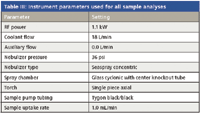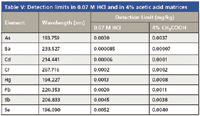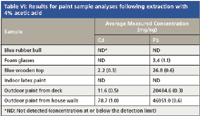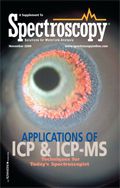Determination of Toxic Elements Leached from Toys and Household Structures by Inductively Coupled Plasma–Optical Emission Spectroscopy
Analyis of lead paint in toys using ICP-OES
Recently, the world's attention has turned to the toxic element content found in the painted surfaces of consumer products. The U.S. Consumer Product Safety Commission (CPSC) has responded to this interest by lowering the maximum permissible lead levels allowed in paint from 600 mg/kg to 90 mg/kg (16 CFR part 1303). In this work, the determination of leachable toxic elements from a variety of paint samples by inductively coupled plasma–optical emission spectroscopy is described. Paint samples included indoor and outdoor house paint, paint scraped from plastic and wooden toys, and paint scraped from the handle of screwdrivers. Toxic elements were leached from paint samples using either 0.07 M hydrochloric acid or 4% acetic acid solutions in accordance with protocols outlined in ASTM F963-08 and ASTM C738-94, respectively. Results between extraction methods were compared and detection limits in each acid matrix were calculated.
Recognition of the adverse effects of human exposure to toxic elements leached from painted surfaces has increased significantly over the last two decades. These elements are used commonly in paint pigments and as paint additives to increase the speed with which paint dries after application and to improve its durability and resistance to mildew corrosion. Lead(II) chromate (PbCrO4), lead(II) carbonate (PbCO3), and lead oxide (Pb3O4) are responsible for paint colors referred to as "chrome yellow," "white lead," and "red lead," respectively.
Lead and other toxic elements also are used in the toy manufacturing process and can be concentrated particularly in those toys made out of plastic. Painted toys sometimes contain lead-based paint that gives them a durable, brightly colored outer surface, as illustrated in Figure 1. Plastic toys contain additional amounts of lead to increase the flexibility of the material and to make it more resistant to warping from heat and sunlight.

Figure 1: Yellow-painted plastic toy car.
When the paint is in good condition, homes and toys pose little or no health risk. The concern arises when these paints peel or crack as they age and deteriorate or when a painted surface is scraped, sanded, or heated. Exposure to high concentrations of these toxic elements could be a risk if the paint chips are ingested or if dust from the paint is inhaled.
In response to this potential health threat, a number of regulatory agencies have set maximum limits on the concentrations of toxic elements in paint and in various consumer products. The U.S. Consumer Product Safety Commission (CPSC) set the maximum allowable lead content in paint to 0.009% (90 mg/kg) as outlined in the Code of Federal Regulations (16 CFR part 1303). This limit, reduced from 0.06% (600 mg/kg), went into effect in August 2009 (1).
The European Union set limits on the maximum allowable concentrations of toxic elements that can be leached from toys and those limits are outlined in EN 71, part 3 (2). These regulations have been adopted by the U.S. CPSC and have been incorporated into guidelines set by the International Organization for Standardization (ISO) regarding toy safety (ISO 8124 part 3). A summary of those guidelines is outlined in Table I. Toy samples that are tested under these regulations must be prepared for analysis according to the hydrochloric acid leaching procedure outlined in test method ASTM F963-08 (3).

Table I: Limits of element migration from toy materials as outlined in ASTM F963-08
The U.S. Food and Drug Administration (FDA) set guidelines for the maximum amount of cadmium and lead that can be leached from a variety of ceramic and flatware materials. All items that fall under these regulations are intended for use with food and leachable limits for cadmium and lead vary depending upon the end use of the material (see Table II). The FDA refers to a leaching procedure with acetic acid, outlined in test method ASTM C738-94 (4), for testing materials that are regulated under FDA guidelines.

Table II: Maximum allowable concentrations of Pb and Cd that can be leached from ceramics, as outlined in ASTM C738-94
Both extraction methods mentioned here are designed to leach toxic elements from paint in a manner that mimics the human digestion process. Total dissolution methods provide accurate and reproducible results for the determination of toxic elements in paint samples and consumer products; however, these methods are not desirable for this application as results do not accurately reflect the concentration of each element that is accessible to the human body upon ingestion of the material.
This article will demonstrate the ability of inductively coupled plasma–optical emission spectroscopy (ICP-OES) to analyze lead-based paints. The sensitivity and large linear dynamic range of the approach will be used to determine a wide range of elements in several different paint samples.
Experimental Conditions
A Dual View Prodigy High Dispersion ICP spectrometer (Teledyne Leeman Labs, Hudson, New Hampshire) equipped with an 88-position autosampler was used to generate the data for this article. The sample introduction system consisted of a four-channel peristaltic pump, a glass cyclonic spray chamber with a center knockout tube, a single-piece quartz torch, and a Seaspray concentric nebulizer (Glass Expansion, Pocasset, Massachusetts). Instrument conditions used for all data collection are listed in Table III.

Table III: Instrument parameters used for all sample analyses
All solutions were prepared using >18 MΩ cm2 water (Barnstead, Dubuque, Iowa) and either reagent grade hydrochloric acid (VWR, West Chester, Pennsylvania) or reagent-grade glacial acetic acid (Aldrich, St. Louis, Missouri). Multielement calibration standards were prepared by dilution from single-element stock solutions (PlasmaPure Standards, Teledyne Leeman Labs) containing 1000 μg/g of As, Ba, Cd, Cr, Hg, Pb, Sb, and Se. All dilutions were performed on a w/w basis. Standards were prepared at relatively low concentrations over a short range to cover the low concentrations expected in solution following extractions of the paint samples. Standards were prepared in two acid matrices that were carefully matched to those in the prepared paint samples (0.07 M HCl and 4% CH3COOH). The concentrations used for calibration are listed in Table IV.

Table IV: Calibration standard concentrations, prepared in both 0.07 M HCl and 4% acetic acid matrices
Various paint samples were prepared for analysis according to extraction methods outlined in ASTM F963-08 and ASTM C738-94. Paint samples included red and blue paint from rubber balls, yellow paint from a plastic toy car, blue paint from a wooden spinning top, red paint from trees associated with a train set, red paint from a children's plastic workshop set, yellow paint from the handle of a screwdriver, indoor latex house paint, oil-based exterior paint scraped from the deck and outdoor walls of a house, and a certified reference material, Trace Metals in Paint Chips (RTC CRM013-050, lot# AW13).
For those samples extracted according to ASTM F963-08, approximately 100 mg of each paint sample was weighed into a 20-mL polypropylene beaker and the exact weight was recorded. To each beaker, 5 mL of 0.07 M HCl was added and all beakers were heated to 37 °C on a hot plate for 2 h in the dark. All samples were agitated for the first hour of heating and were allowed to sit without agitation for the second hour of heating. After cooling, samples were filtered through 0.45-μm filter paper and the final volume was recorded.
For samples extracted according to ASTM C738-94, approximately 100 mg of each paint sample was weighed into a 50-mL polypropylene volumetric centrifuge tube (VWR, West Chester, Pennsylvania) and the exact weight was recorded. To each tube, 10 mL of 4% CH3COOH was added and all tubes were allowed to sit for 24 h in darkness. Samples were then filtered through 0.45-μm filter paper and the final volume was recorded.
After the plasma was ignited, the instrument was allowed to warm up for 15 min before the torch observation height was set using standard 5 (see Table IV). Following calibration, a detection limit study was performed to determine the instrument's detection limits for the elements of interest in 0.07 M hydrochloric acid and 4% acetic acid matrices. The instrument detection limit (IDL) for each analyte was calculated to be the concentration equal to three times the standard deviation of 10 replicate measurements of the calibration blank.

Table V: Detection limits in 0.07 M HCl and in 4% acetic acid matrices
Results and Discussion
Results for IDLs in both acid matrices and are reported in Table V. Results in Table V indicate that the detection limits are more than sufficient for determining whether the analytes of interest are present at concentrations that exceed the regulatory requirements outlined earlier.

Table VI: Results for paint sample analyses following extraction with 4% acetic acid
Results for the analysis of paint samples following acetic acid and hydrochloric acid extractions are listed in Tables VI and VII, respectively. Numbers in parentheses represent %RSD values for the corresponding measured analyte concentration, both in units of milligrams per kilogram unless otherwise specified. Results in both tables are listed in units of milligram per kilogram and reflect the concentration in the original solid material. Results in Table VIII have been corrected using the analytical correction factors outlined in Section 8.3.4.3 of ASTM F963-08. The correction factors are as follows: As, 60%; Ba, 30%; Cd, 30%; Cr, 30%; Hg, 50%; Pb, 30%; Sb, 60%; and Se, 60%.

Table VII: Results for paint sample analyses following extraction with 0.07 M HCl
Results from Table VII indicate that the blue wooden top contains lead at a concentration that exceeds limits regulated by the U.S. CSPC. If all samples tested in this work were regulated under U.S. CSPC guidelines for migratory elements, the yellow screwdriver handle, the indoor paint sample, and both outdoor paint samples would exceed regulatory limits for lead. The yellow screwdriver handle would also exceed limits for chromium.

Table VIII: Comparison of acetic and hydrochloric acid extraction procedures based on results for Pb and Cd
Results for several samples from Tables VI and VII along with results from the certified reference material are listed in Table VIII for comparison between the two extraction procedures. Results for the certified reference material are included for evaluating the efficiency with which cadmium and lead can be extracted from material containing a known concentration of each analyte (certified values for cadmium and lead in the CRM sample are 37.8 μg/g and 643 ?g/g, respectively). Numbers in parentheses represent %RSD values for the corresponding measured analyte concentration, and all results and RSD values are listed in units of milligram per kilogram unless otherwise specified. Because the acetic acid extraction specifically targets cadmium and lead, only results for cadmium and lead were selected for comparison.
Results in Table VIII demonstrate the significant variability between extraction methods as well as variability within each extraction method. Results for duplicate preparations of the certified reference material further illustrate the challenges associated with obtaining reproducible results and indicate the reason that certified reference materials are not used for validating these extraction methods. Results indicate that the hydrochloric acid extraction procedure generally is more aggressive than the acetic acid procedure; however, a total dissolution method is needed to obtain results for cadmium and lead that would fall within the accepted concentration range for certified reference materials.
Conclusion
The determination of eight toxic elements in paint and in painted surfaces of consumer products following two different acid extractions has been presented. The extraction methods were designed to simulate the ingestion of paint flaked from the surface of a consumer product and results would reflect the concentration of each element that the human body could leach out during digestion.
Samples containing concentrations of lead and cadmium that exceed FDA regulated limits can be determined using both the acetic and hydrochloric acid extraction methods, regardless of the variability exhibited in the results from each extraction. The hydrochloric acid extraction is recommended for testing products regulated under U.S. CSPC guidelines. Hydrochloric acid was a more aggressive leaching solution and would provide a more conservative estimate of the potential for exposure to toxic elements upon ingestion of the product in question.
Maura Mahar, Manuel Almeida, and Peter Brown are with Teledyne Leeman Labs, Hudson, New Hampshire.
References
(1) Consumer Product Safety Commission, Code of Federal Regulations, 16 CFR part 1303, Ban of Lead-Containing Paint and Certain Consumer Products Bearing Lead-Containing Paint.
(2) European Standard on Safety of Toys, EN 71 part 3, Migration of Certain Elements.
(3) American Society for Testing and Materials (ASTM) International, ASTM F963-08, Standard Consumer Safety Specification for Toy Safety.
(4) American Society for Testing and Materials (ASTM) International, ASTM C738-94(2006), Standard Test Method for Lead and Cadmium Extracted from Glazed Ceramic Surfaces.
